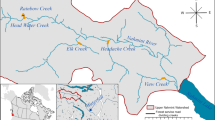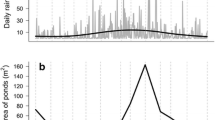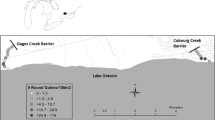Summary
We studied the rainy season dispersal of the fish Poecilia gillii (Poeciliidae) from pools in a steepgradient, intermittent stream in Santa Rosa National Park, Costa Rica. The stream consisted of about 20 pools separated by dry streambed except during two floods and subsequent brief periods of flow. Individually recognizable tags permitted mark-recapture estimates of population size and information on individual movements. The first flood was very severe, with pools losing an average of 75% of their populations (range 12–99%). Most of the lost fish died by becoming trapped in desiccating pools. Males and juveniles were more likely to be lost than were females. Population loss was negatively related to pool volume and positively related to streambed slope. In addition, population loss was positively related to preflood population size when the effects of pool volume and slope were removed indicating that pools with higher densities lost more fish. Of the fish recaptured after the flood, the average proportion found in the pool in which they had been tagged varied from 16%–96%, depending on the area of the stream. Of fish that moved, 92% went downstream. The second flood was less severe though stream flow lasted as long, and there was little effect on the pool populations. Involuntary flushing during the flood and voluntary departure apparently interacted to produce the observed patterns.
Similar content being viewed by others
References
Awachie JBE (1981) Running water ecology in Africa. In: Lock MA, Williams DD (eds) Perspectives in running water ecology. Plenum Press, New York, pp 339–366
Bayley PB (1971) The ecology and fisheries of the River Pilcomayo in Bolivia. Ministerio de Asuntos Campestinos Y Agricultura Asesores Britanicos en Agricultura Tropical, Santa Cruz, Bolivia
Bonetto AA, Cordiviola de Yuan E, Pignalberi C, Oliveros O (1969) Ciclos hidrológicos del Rio Paraná y las poblaciones de peces contenidas en las cuencas temporarias de su valle de inundación. Physis, Buenos Aires 29:213–223
Brown KL (1985) Demographic and genetic characteristics of dispersal in the mosquitofish Gambusia affinis (Pisces: Poeciliidae). Copeia 1985:597–612
Bussing WA (1987) Peces de las Aguas Continentales de Costa Rica. Editorial de la Universidad de Costa Rica, San José
Chapman LJ (1990) Population ecology of the fish Poecilia gilliii in an intermittent tropical stream: the effects of seasonal flooding. Ph.D. thesis, McGill University, Montreal, Canada
Chapman LJ, Kramer DL, Chapman CA (1991). Population dynamics of the fish Poecilia gillii (Poeciliidae) in pools of an intermittent tropical stream J Anim Ecol 60:
Chapman LJ, Bevan D (1990) Development and field evaluation of a “minispaghetti” tag for individual identification of small fishes. Proceedings of the International Symposium and Educational Workshop on Fish-Marking Techniques. Am Fisher Soc Symp 7:101–108
Gandolfi G (1971) Sexual selection in relation to the social status of males in Poecilia reticulata (Teleostii: Poeciliidae). Boll Zool 38:35–48
Gibson RN (1969) The biology and behaviour of littoral fish. Oceanog Mar Biol, Ann Rev 7:367–410
Gibson RN (1986) Intertidal teleosts: life in a fluctuating environment. In Pitcher TJ (ed) The behaviour of teleost fishes. Croom Helm Limited, London, pp 388–408
Goulding M (1980) The fishes and the forest. University of California Press, Berkeley, CA
Harden Jones FR (1968) Fish migration. Edward Arnold Limited, London
Hardy AC, Milne PS (1938) Studies in the distribution of insects by aerial currents. Experiments in aerial tow-netting from kites. J Anim Ecol 7:199–229
Harvey BC (1987) Susceptibility of young-of-the-year fishes to downstream displacement by flooding. Trans Amer Fish Soc 116:851–855
Heath MR, MacLachlan PM, Martin JHA (1987) Inshore circulation and transport of herring larvae off the north coast of Scotland. Mar Ecol Prog Ser 40:11–23
Hughes AL (1985) Male size, mating success, and mating strategy in the mosquitofish Gambusia affinis (Poeciliidae). Behav Ecol Sociobiol 17:271–278
John KR (1964) Survival of fish in intermittent streams of the Chiricahua mountains, Arizona. Ecology 45:112–119
Johnels AG (1954) Notes on fishes from the Gambia River. Arkiv Zool, Ser 26:327–411
Krebs CJ (1989) Ecological methodology. Harper and Row, Publishers, New York
Kushlan JA (1974) Effects of a natural fishkill on water quality, plankton, and fish production of a pond in the Big Cypress Swamp, Florida Trans Am Fish Soc 103:235–243
Lidicker WZ Jr, Caldwell RL (1982) Editors' comments. In: Lidicker WZ Jr, Caldwell RL (eds) Dispersal and migration. Hutchinson Ross Publishing Company, New York
Lowe-McConnell RH (1964) The fishes of the Rupununi savanna district of British Guiana, South America. Pt. I. Ecological groupings of fish species and effects of the seasonal cycle on the fish. J Linn Soc 45:103–144
Lowe-McConnell RH (1975) Fish communities in tropical fresh-waters. Longman, London
Lowe-McConnell RH (1979) Ecological aspects of seasonality in fishes of tropical waters. Symp Zool Soc Lond 44:219–241
Matthews WJ (1986) Fish faunal structure in an Ozark stream: stability, persistence, and a catastrophic flood. Copeia 1986:388–397
McKay FE (1971) Behavioural aspects of population dynamics in unisexual-bisexual Poeciliopsis (Pisces: Poeciliidae). Ecology 52:778–790
Meffe GK (1984) Effects of a biotic disturbance on coexistence of predator-prey fish species. Ecology 65:1524–1534
Mileikovsky SA (1971) Types of larval development in marine bottom invertebrates. Their distribution and ecological significance: a reevaluation. Mar Biol 10:193–213
Moore WS, McKay FE (1971) Coexistence in unisexual-bisexual species complexes of Poeciliopsis (Pisces: Poeciliidae). Ecology 52:791–799
Noltie DB, Johansen PH (1986) Laboratory studies of microhabitat selection by the guppy, Poecilia reticulata (Peters). J. Freshwater Ecol 3:299–307
Rainey RC (1951) Weather and the movements of locust swarms: a new hypothesis. Nature 168:1057–1060
Riley JD (1966) Liquid latex marking technique for small fish. J Cons Perm Int Explor Mer. 30:354–357
Roberts TR (1973) Ecology of fishes in the Amazon and Congo basins. In Meggers BJ, Ayensu ES, Duckworth WD (eds) Tropical forest ecosystems in Africa and South America: a comparative review. Smithsonian Institution Press, Washington DC, pp 239–254
Robertson R (1964) Dispersal and wastage of larval Philippia krebsii (Gastropoda: Architectonicidae) in the North Atlantic. Proc Acad Nat Sci Phila 161:1–27
Rose SM (1959) Population control in guppies. Am Midl Nat 62:474–481
Scheltema RS (1968) Dispersal of larvae by equatorial ocean currents and its importance to the zoogeography of shoal-water tropical species. Nature 217:1159–1162
Schoonoord MP, Maitland PS (1983) Some methods of marking larval lampreys (Petromyzonidae). Fish Manag 14:33–38
Showers WB, Whitford F, Smelser RB, Keaster AJ, Robinson JF, Lopez JD (1989) Direct evidence for meteorologically driven long-range dispersal of an economically important moth. Ecology 70:987–992
Smith NJH (1981) Man, fishes, and the Amazon. Columbia University Press, New York
Southwood TRE (1962) Migration of terrestrial arthropods in relation to habitat. Biol Rev 37:171–214
Strathmann RR (1974) The spread of sibling larvae of sedentary marine invertebrates. Am Nat 108:29–44
Talbot LM, Talbot MH (1963) The wildebeest in Western Masailand, East Africa Wild Monog 12:8–88
Thibault RE (1974) Genetics of cannibalism in a viviparous fish and its relationship to population density. Nature 251:138–140
Thresher RE, Gronell AM (1978) Subcutaneous tagging of small reef fishes. Copeia 1978:352–353
Turner CL (1941) Morphogenesis of the gonopodium in Gambusia affinis affinis J Morphol 69:161–185
Waloff Z (1972) Orientation of flying locusts, Schistocerca gregaria (Forsk.), in migrating swarms. Bull Ent Res 62:1–72
Welcomme RL (1979) Fisheries ecology of floodplain rivers. Longman, New York
Author information
Authors and Affiliations
Rights and permissions
About this article
Cite this article
Chapman, L.J., Kramer, D.L. The consequences of flooding for the dispersal and fate of poeciliid fish in an intermittent tropical stream. Oecologia 87, 299–306 (1991). https://doi.org/10.1007/BF00325270
Received:
Accepted:
Issue Date:
DOI: https://doi.org/10.1007/BF00325270




